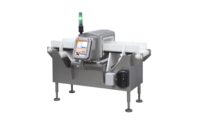

While food safety efforts to prevent microbial contamination of product are top of mind for every meat and poultry processor and product handler, the related production consideration of preventing foreign materials introduction is equally important. Although foreign materials contamination of food products does not pose the same threat for contamination as a microbial threat such as Salmonella, X-ray and metal detection systems are essential components of industry food safety plans. There also is growing processor interest in and use of vision systems for foreign material detection and quality control.
Despite whatever array of detection technologies processors implement, it is just one part of a company’s comprehensive foreign materials detection and prevention commitment.
“No detection method is perfect, and all possess the potential for false predictions, to some degree,”
said Casey Lynn Gallimore, director of regulatory policy at the North American Meat Institute (NAMI).
Although USDA does not specify a regulatory requirement specific to foreign materials prevention, NAMI has compiled best practices to guide processors in setting up foreign material prevention procedures.
“There is no regulatory requirement specific to physical hazards in product, except for meeting the Federal Meat Inspection Act of providing safe, wholesome, unadulterated meat products,” Gallimore said. ”USDA does not identify a certain size limit of a physical hazard, where anything above a certain size or dimension would be a hazard. FDA has standards for what is allowed as limits in FDA inspected product, it is recommended to use those limits in meat products, unless other support is available.”
Using these limits would support whether or not product was safe for consumption and would also aid plant workers in identifying if the product is salvageable or not, Gallimore said.
For example, if sawdust fell into some chopped and formed product and this was realized after the fact and the sawdust pieces were smaller than what has been identified by FDA as a hazard. The issue would become a quality issue at that point, she said. USDA-FSIS considers all product with foreign material to be adulterated regardless of the size, shape or any other characteristics of the material.
“Though that sounds good in theory and the industry has made significant improvements to reduce the occurrence of foreign material in meat and poultry products, it is an unrealistic standard that is inconsistent with FDA enforcement of other foods,” Gallimore said. “Having zero foreign material is an admirable goal, but companies are better served using a risk-based approach with a zero-tolerance standard for foreign material that would be a food safety hazard.”
Through participation in an industrywide partnership of meat and poultry associations NAMI has complied and outlined key questions processors must address and approaches they can employ when designing and implementing a foreign material control and prevention program. NAMI’s “The Meat and Poultry Industry Foreign Material Manual” is designed as a comprehensive information resource for processors to consult when crafting their foreign material control efforts for prevention, detection and response.
Different processing applications necessitate tailored solutions for foreign material control and prevention. Best practices and equipment for a hamburger line, chicken wings or hot dogs can have unique aspects. Processors’ foreign material control and prevention programs should start with risk assessment to identify potential areas for foreign materials introduction during the production process.
“There is no silver bullet or magic one-size-fits-all solution for foreign material control and prevention,” Gallimore said. “It is important to design a program that is specific to the establishment and grounded in a robust risk assessment. Though there are some processes where a single control or prevention method might suffice, we generally recommend a multi-hurdle approach, and the risk assessment will drive the number and type of methods to use. “
Processors must also keep in mind that risk assessments should be re-evaluated as significant changes
to the production process are incorporated, such as a new product line, new materials or new vendors.
“The essential best practices for ensuring the metal detection and X-ray technology are functioning as intended are ensuring the calibrations are conducted at appropriate intervals, and that corrective actions, when needed, address the issue,” said Abbey Davidson, outreach specialist the American Association of Meat Processors (AAMP). “Processing facilities that process thousands of pounds of product each day should have a more frequent calibration frequency than those facilities that only process a few hundred pounds of product a day.”
She said that having a product hold procedure in place to prevent the risk that product with potential physical hazards is released into commerce is essential, adding that well-trained staff members are vital in making sure sound procedures are implemented and followed.
For metal detection systems, for example, metals with high electrical conductivity like aluminum or brass retransmit a stronger electromagnetic field and are easier to detect. In a meat processing operation, however, stainless steel (one of the most common metals used in meat and poultry processing environments because of its anti-corrosive properties) has low electrical conductivity and can be more difficult to detect. This is why different sizes of standards are often used for calibration.
“Making sure that the different types of metal are calibrated for ferrous, non-ferrous and stainless steel is vital,” Davidson said. “These types of equipment can be finicky, so working with and understanding how your specific piece of equipment operates will save much headache in the long run.”
She added that the second part to this is that staff knows and understands proper use and calibration of detection systems and implements the important actions when issues arise.
“This means that staff knows how to identify the implicated product, segregate it from other products, understand what to do in the event the product cannot be used, and how to find that out,” she said.

.png?height=96&t=1647275041&width=96)



Report Abusive Comment